University Report: Analysis of Indian Economic Performance (MS40048E)
VerifiedAdded on 2022/10/01
|13
|2873
|280
Report
AI Summary
This report provides a detailed analysis of the Indian economy, examining its performance through various macroeconomic indicators. It begins with an introduction to the Indian economy as a developing, market-based system and its aspirations for future growth. The report then delves into an analysis of key economic factors, including Gross Domestic Product (GDP), GDP growth rate, and per capita GDP, assessing their trends and implications. It further explores unemployment rates, inflation, and net export, providing insights into the challenges and opportunities within the Indian economic landscape. The analysis covers the period from 2015 to 2018, highlighting the impact of factors like private consumption, government expenditure, and trade deficits. The report concludes by summarizing the key findings and offering a comprehensive overview of the current economic state of India, emphasizing the importance of economic reforms and addressing the challenges of unemployment and trade imbalances.
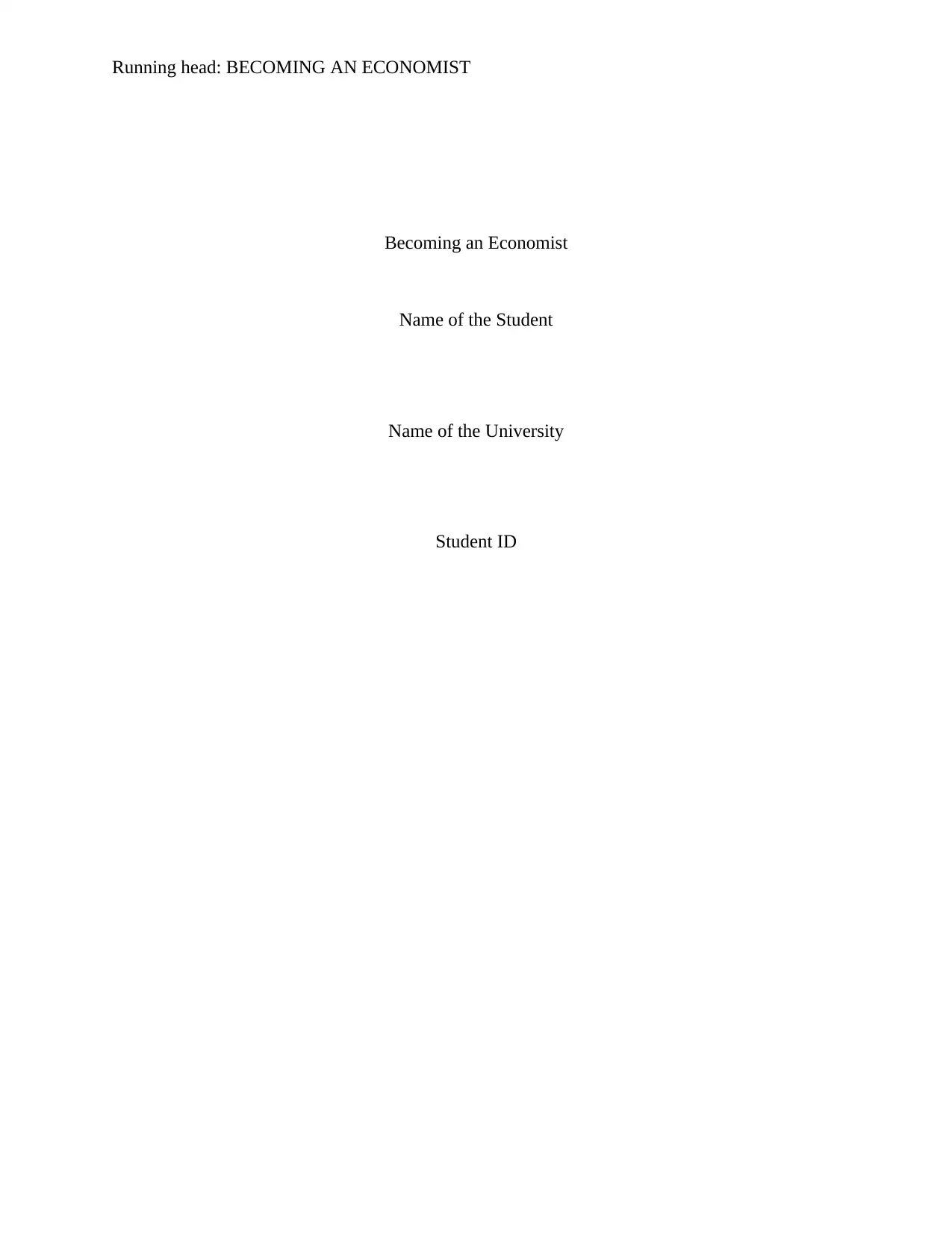
Running head: BECOMING AN ECONOMIST
Becoming an Economist
Name of the Student
Name of the University
Student ID
Becoming an Economist
Name of the Student
Name of the University
Student ID
Paraphrase This Document
Need a fresh take? Get an instant paraphrase of this document with our AI Paraphraser
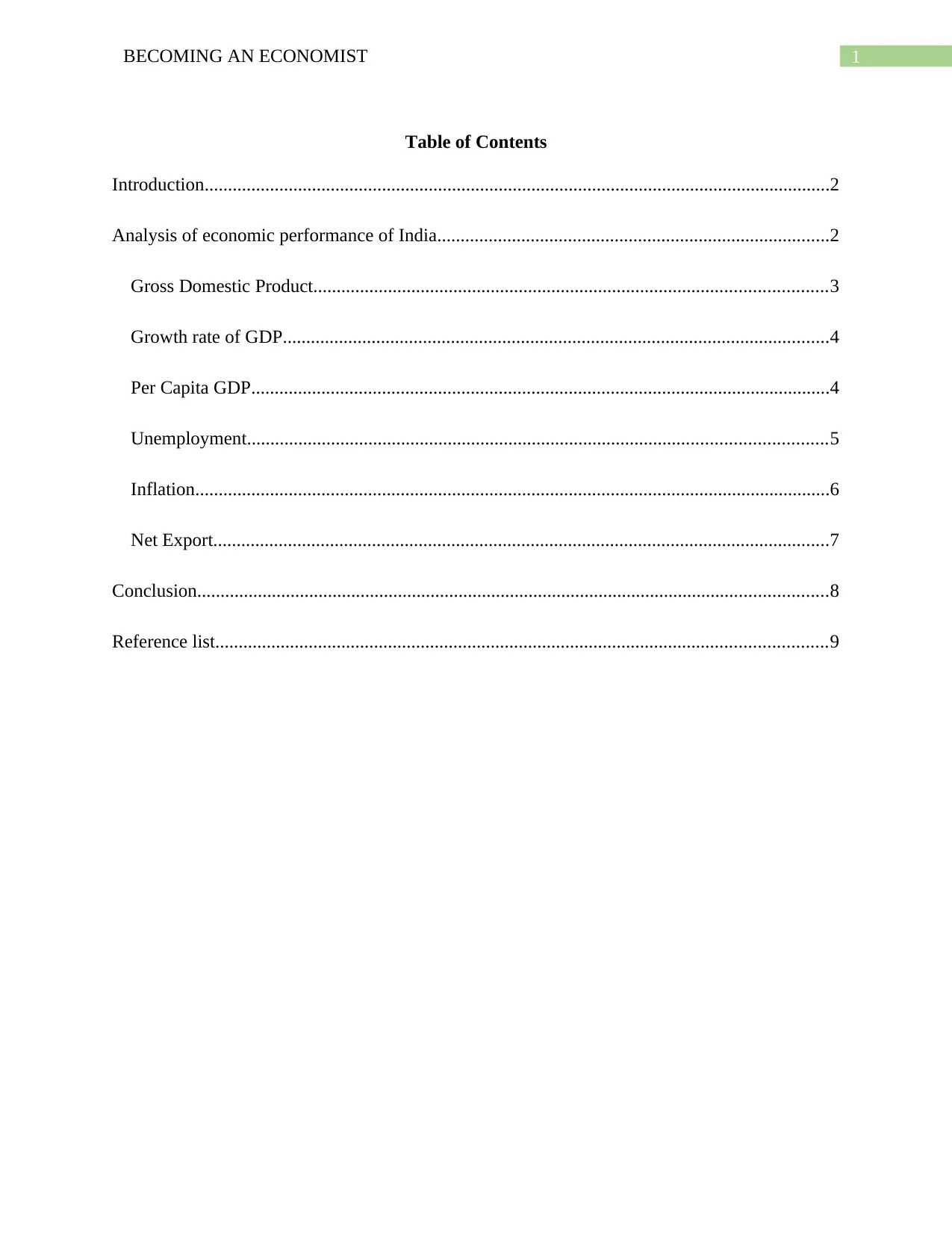
1BECOMING AN ECONOMIST
Table of Contents
Introduction......................................................................................................................................2
Analysis of economic performance of India....................................................................................2
Gross Domestic Product..............................................................................................................3
Growth rate of GDP.....................................................................................................................4
Per Capita GDP............................................................................................................................4
Unemployment............................................................................................................................5
Inflation........................................................................................................................................6
Net Export....................................................................................................................................7
Conclusion.......................................................................................................................................8
Reference list...................................................................................................................................9
Table of Contents
Introduction......................................................................................................................................2
Analysis of economic performance of India....................................................................................2
Gross Domestic Product..............................................................................................................3
Growth rate of GDP.....................................................................................................................4
Per Capita GDP............................................................................................................................4
Unemployment............................................................................................................................5
Inflation........................................................................................................................................6
Net Export....................................................................................................................................7
Conclusion.......................................................................................................................................8
Reference list...................................................................................................................................9
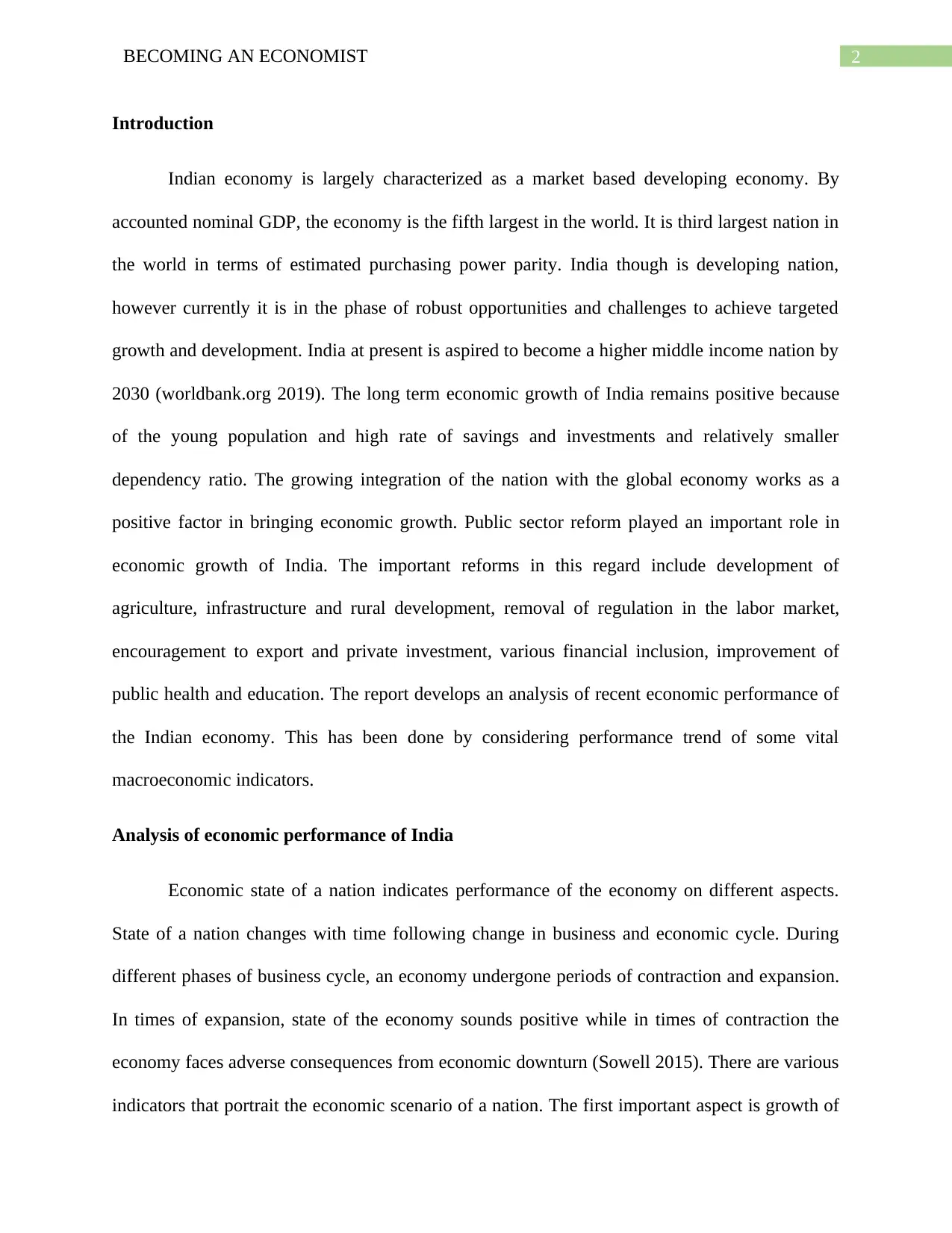
2BECOMING AN ECONOMIST
Introduction
Indian economy is largely characterized as a market based developing economy. By
accounted nominal GDP, the economy is the fifth largest in the world. It is third largest nation in
the world in terms of estimated purchasing power parity. India though is developing nation,
however currently it is in the phase of robust opportunities and challenges to achieve targeted
growth and development. India at present is aspired to become a higher middle income nation by
2030 (worldbank.org 2019). The long term economic growth of India remains positive because
of the young population and high rate of savings and investments and relatively smaller
dependency ratio. The growing integration of the nation with the global economy works as a
positive factor in bringing economic growth. Public sector reform played an important role in
economic growth of India. The important reforms in this regard include development of
agriculture, infrastructure and rural development, removal of regulation in the labor market,
encouragement to export and private investment, various financial inclusion, improvement of
public health and education. The report develops an analysis of recent economic performance of
the Indian economy. This has been done by considering performance trend of some vital
macroeconomic indicators.
Analysis of economic performance of India
Economic state of a nation indicates performance of the economy on different aspects.
State of a nation changes with time following change in business and economic cycle. During
different phases of business cycle, an economy undergone periods of contraction and expansion.
In times of expansion, state of the economy sounds positive while in times of contraction the
economy faces adverse consequences from economic downturn (Sowell 2015). There are various
indicators that portrait the economic scenario of a nation. The first important aspect is growth of
Introduction
Indian economy is largely characterized as a market based developing economy. By
accounted nominal GDP, the economy is the fifth largest in the world. It is third largest nation in
the world in terms of estimated purchasing power parity. India though is developing nation,
however currently it is in the phase of robust opportunities and challenges to achieve targeted
growth and development. India at present is aspired to become a higher middle income nation by
2030 (worldbank.org 2019). The long term economic growth of India remains positive because
of the young population and high rate of savings and investments and relatively smaller
dependency ratio. The growing integration of the nation with the global economy works as a
positive factor in bringing economic growth. Public sector reform played an important role in
economic growth of India. The important reforms in this regard include development of
agriculture, infrastructure and rural development, removal of regulation in the labor market,
encouragement to export and private investment, various financial inclusion, improvement of
public health and education. The report develops an analysis of recent economic performance of
the Indian economy. This has been done by considering performance trend of some vital
macroeconomic indicators.
Analysis of economic performance of India
Economic state of a nation indicates performance of the economy on different aspects.
State of a nation changes with time following change in business and economic cycle. During
different phases of business cycle, an economy undergone periods of contraction and expansion.
In times of expansion, state of the economy sounds positive while in times of contraction the
economy faces adverse consequences from economic downturn (Sowell 2015). There are various
indicators that portrait the economic scenario of a nation. The first important aspect is growth of
⊘ This is a preview!⊘
Do you want full access?
Subscribe today to unlock all pages.

Trusted by 1+ million students worldwide
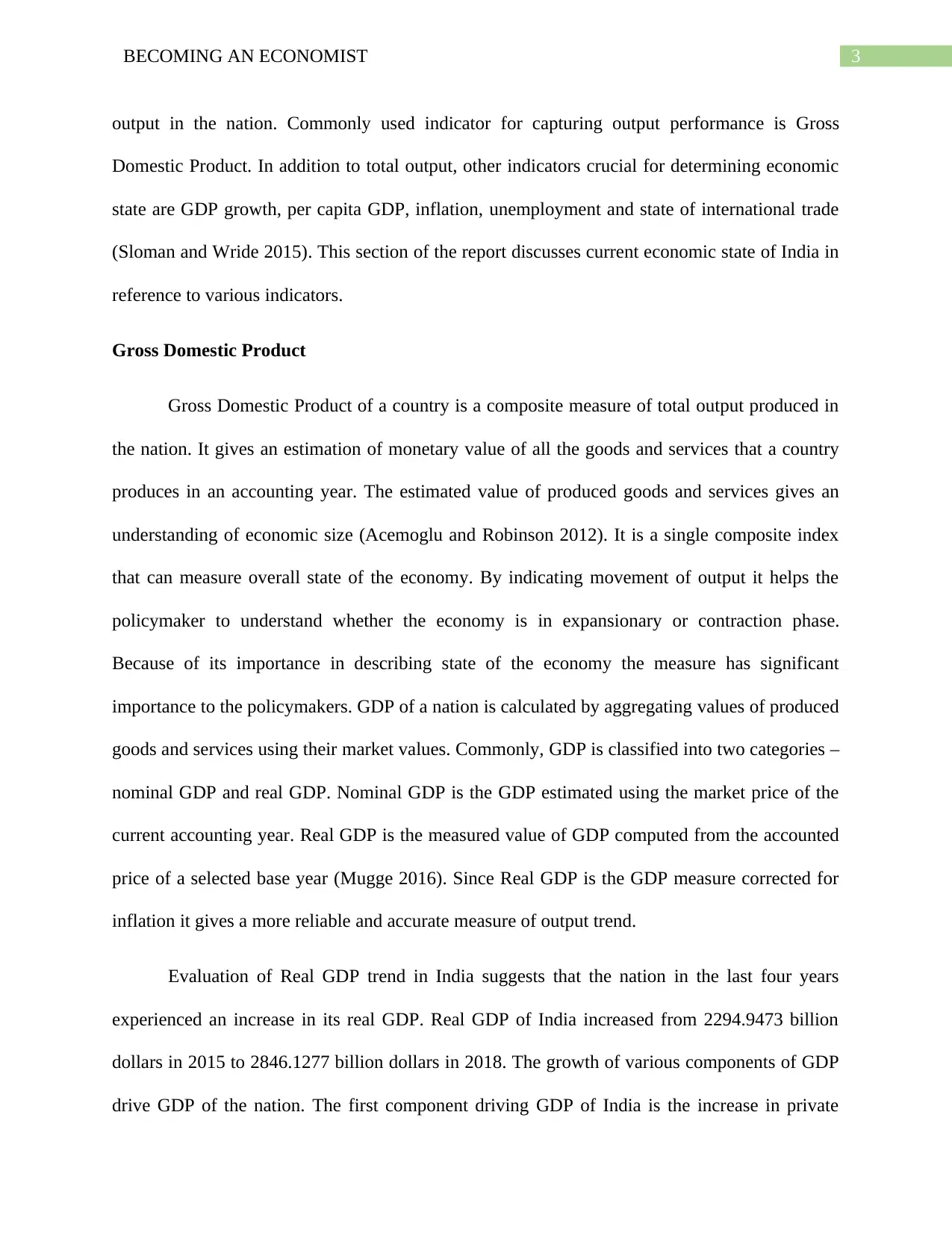
3BECOMING AN ECONOMIST
output in the nation. Commonly used indicator for capturing output performance is Gross
Domestic Product. In addition to total output, other indicators crucial for determining economic
state are GDP growth, per capita GDP, inflation, unemployment and state of international trade
(Sloman and Wride 2015). This section of the report discusses current economic state of India in
reference to various indicators.
Gross Domestic Product
Gross Domestic Product of a country is a composite measure of total output produced in
the nation. It gives an estimation of monetary value of all the goods and services that a country
produces in an accounting year. The estimated value of produced goods and services gives an
understanding of economic size (Acemoglu and Robinson 2012). It is a single composite index
that can measure overall state of the economy. By indicating movement of output it helps the
policymaker to understand whether the economy is in expansionary or contraction phase.
Because of its importance in describing state of the economy the measure has significant
importance to the policymakers. GDP of a nation is calculated by aggregating values of produced
goods and services using their market values. Commonly, GDP is classified into two categories –
nominal GDP and real GDP. Nominal GDP is the GDP estimated using the market price of the
current accounting year. Real GDP is the measured value of GDP computed from the accounted
price of a selected base year (Mugge 2016). Since Real GDP is the GDP measure corrected for
inflation it gives a more reliable and accurate measure of output trend.
Evaluation of Real GDP trend in India suggests that the nation in the last four years
experienced an increase in its real GDP. Real GDP of India increased from 2294.9473 billion
dollars in 2015 to 2846.1277 billion dollars in 2018. The growth of various components of GDP
drive GDP of the nation. The first component driving GDP of India is the increase in private
output in the nation. Commonly used indicator for capturing output performance is Gross
Domestic Product. In addition to total output, other indicators crucial for determining economic
state are GDP growth, per capita GDP, inflation, unemployment and state of international trade
(Sloman and Wride 2015). This section of the report discusses current economic state of India in
reference to various indicators.
Gross Domestic Product
Gross Domestic Product of a country is a composite measure of total output produced in
the nation. It gives an estimation of monetary value of all the goods and services that a country
produces in an accounting year. The estimated value of produced goods and services gives an
understanding of economic size (Acemoglu and Robinson 2012). It is a single composite index
that can measure overall state of the economy. By indicating movement of output it helps the
policymaker to understand whether the economy is in expansionary or contraction phase.
Because of its importance in describing state of the economy the measure has significant
importance to the policymakers. GDP of a nation is calculated by aggregating values of produced
goods and services using their market values. Commonly, GDP is classified into two categories –
nominal GDP and real GDP. Nominal GDP is the GDP estimated using the market price of the
current accounting year. Real GDP is the measured value of GDP computed from the accounted
price of a selected base year (Mugge 2016). Since Real GDP is the GDP measure corrected for
inflation it gives a more reliable and accurate measure of output trend.
Evaluation of Real GDP trend in India suggests that the nation in the last four years
experienced an increase in its real GDP. Real GDP of India increased from 2294.9473 billion
dollars in 2015 to 2846.1277 billion dollars in 2018. The growth of various components of GDP
drive GDP of the nation. The first component driving GDP of India is the increase in private
Paraphrase This Document
Need a fresh take? Get an instant paraphrase of this document with our AI Paraphraser
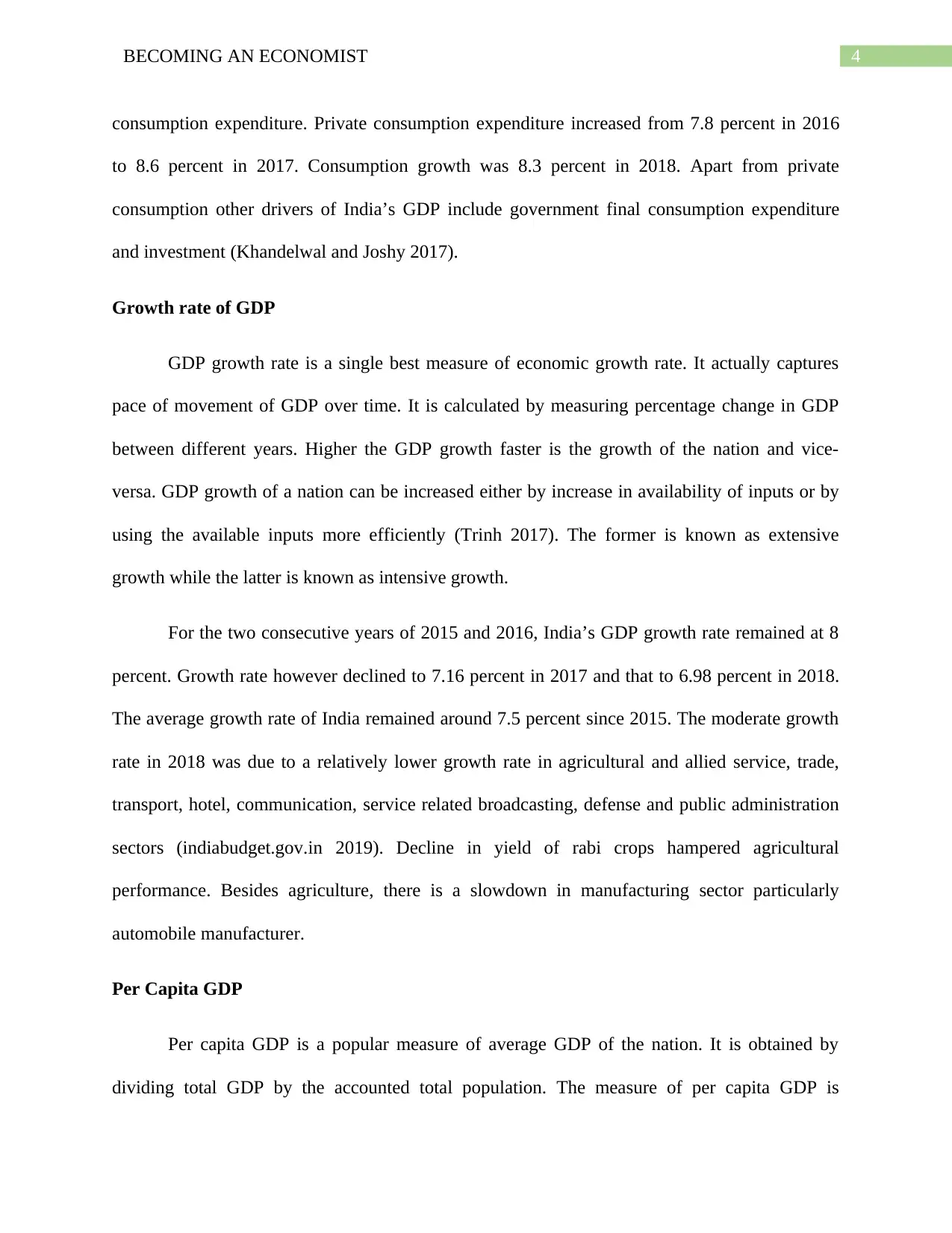
4BECOMING AN ECONOMIST
consumption expenditure. Private consumption expenditure increased from 7.8 percent in 2016
to 8.6 percent in 2017. Consumption growth was 8.3 percent in 2018. Apart from private
consumption other drivers of India’s GDP include government final consumption expenditure
and investment (Khandelwal and Joshy 2017).
Growth rate of GDP
GDP growth rate is a single best measure of economic growth rate. It actually captures
pace of movement of GDP over time. It is calculated by measuring percentage change in GDP
between different years. Higher the GDP growth faster is the growth of the nation and vice-
versa. GDP growth of a nation can be increased either by increase in availability of inputs or by
using the available inputs more efficiently (Trinh 2017). The former is known as extensive
growth while the latter is known as intensive growth.
For the two consecutive years of 2015 and 2016, India’s GDP growth rate remained at 8
percent. Growth rate however declined to 7.16 percent in 2017 and that to 6.98 percent in 2018.
The average growth rate of India remained around 7.5 percent since 2015. The moderate growth
rate in 2018 was due to a relatively lower growth rate in agricultural and allied service, trade,
transport, hotel, communication, service related broadcasting, defense and public administration
sectors (indiabudget.gov.in 2019). Decline in yield of rabi crops hampered agricultural
performance. Besides agriculture, there is a slowdown in manufacturing sector particularly
automobile manufacturer.
Per Capita GDP
Per capita GDP is a popular measure of average GDP of the nation. It is obtained by
dividing total GDP by the accounted total population. The measure of per capita GDP is
consumption expenditure. Private consumption expenditure increased from 7.8 percent in 2016
to 8.6 percent in 2017. Consumption growth was 8.3 percent in 2018. Apart from private
consumption other drivers of India’s GDP include government final consumption expenditure
and investment (Khandelwal and Joshy 2017).
Growth rate of GDP
GDP growth rate is a single best measure of economic growth rate. It actually captures
pace of movement of GDP over time. It is calculated by measuring percentage change in GDP
between different years. Higher the GDP growth faster is the growth of the nation and vice-
versa. GDP growth of a nation can be increased either by increase in availability of inputs or by
using the available inputs more efficiently (Trinh 2017). The former is known as extensive
growth while the latter is known as intensive growth.
For the two consecutive years of 2015 and 2016, India’s GDP growth rate remained at 8
percent. Growth rate however declined to 7.16 percent in 2017 and that to 6.98 percent in 2018.
The average growth rate of India remained around 7.5 percent since 2015. The moderate growth
rate in 2018 was due to a relatively lower growth rate in agricultural and allied service, trade,
transport, hotel, communication, service related broadcasting, defense and public administration
sectors (indiabudget.gov.in 2019). Decline in yield of rabi crops hampered agricultural
performance. Besides agriculture, there is a slowdown in manufacturing sector particularly
automobile manufacturer.
Per Capita GDP
Per capita GDP is a popular measure of average GDP of the nation. It is obtained by
dividing total GDP by the accounted total population. The measure of per capita GDP is
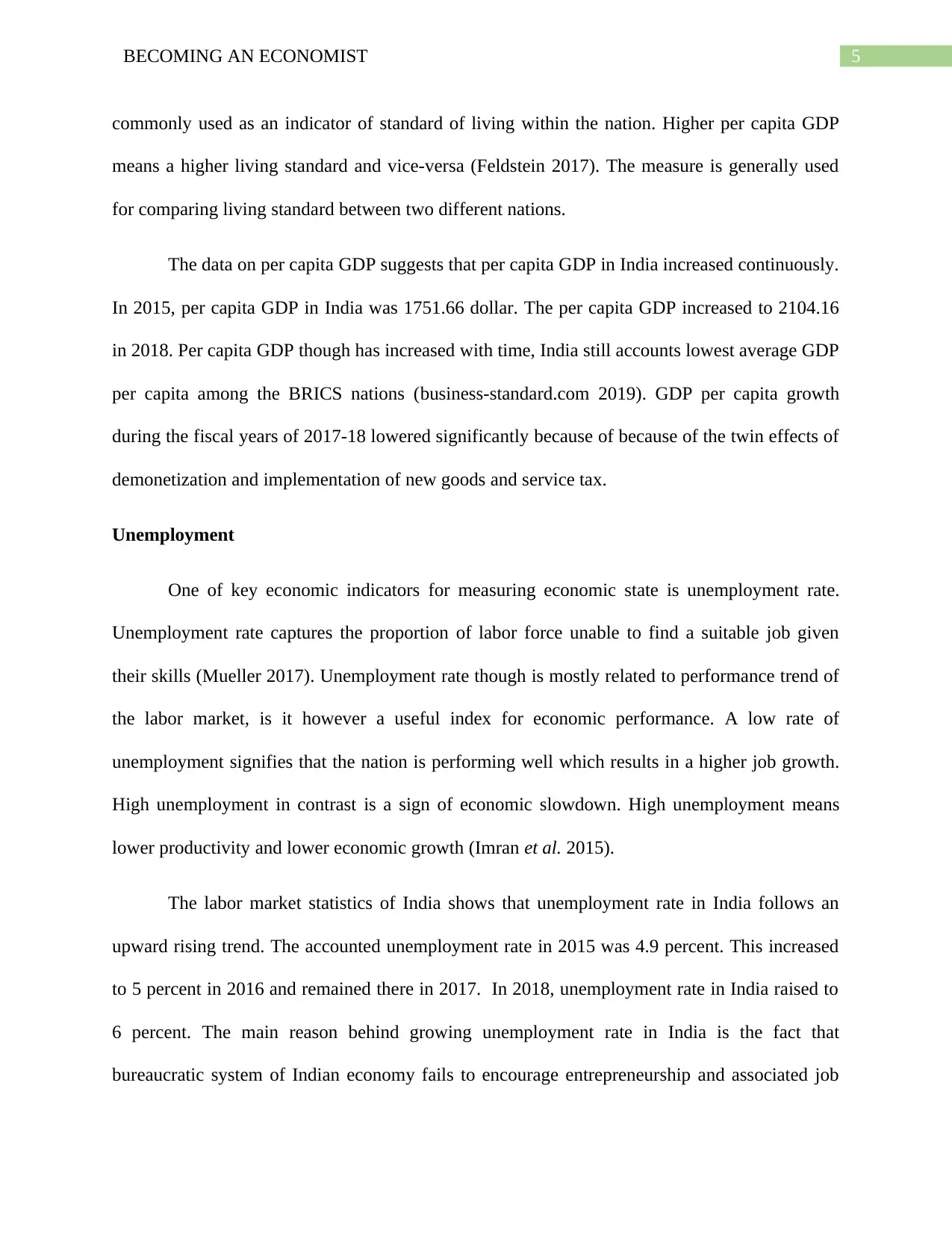
5BECOMING AN ECONOMIST
commonly used as an indicator of standard of living within the nation. Higher per capita GDP
means a higher living standard and vice-versa (Feldstein 2017). The measure is generally used
for comparing living standard between two different nations.
The data on per capita GDP suggests that per capita GDP in India increased continuously.
In 2015, per capita GDP in India was 1751.66 dollar. The per capita GDP increased to 2104.16
in 2018. Per capita GDP though has increased with time, India still accounts lowest average GDP
per capita among the BRICS nations (business-standard.com 2019). GDP per capita growth
during the fiscal years of 2017-18 lowered significantly because of because of the twin effects of
demonetization and implementation of new goods and service tax.
Unemployment
One of key economic indicators for measuring economic state is unemployment rate.
Unemployment rate captures the proportion of labor force unable to find a suitable job given
their skills (Mueller 2017). Unemployment rate though is mostly related to performance trend of
the labor market, is it however a useful index for economic performance. A low rate of
unemployment signifies that the nation is performing well which results in a higher job growth.
High unemployment in contrast is a sign of economic slowdown. High unemployment means
lower productivity and lower economic growth (Imran et al. 2015).
The labor market statistics of India shows that unemployment rate in India follows an
upward rising trend. The accounted unemployment rate in 2015 was 4.9 percent. This increased
to 5 percent in 2016 and remained there in 2017. In 2018, unemployment rate in India raised to
6 percent. The main reason behind growing unemployment rate in India is the fact that
bureaucratic system of Indian economy fails to encourage entrepreneurship and associated job
commonly used as an indicator of standard of living within the nation. Higher per capita GDP
means a higher living standard and vice-versa (Feldstein 2017). The measure is generally used
for comparing living standard between two different nations.
The data on per capita GDP suggests that per capita GDP in India increased continuously.
In 2015, per capita GDP in India was 1751.66 dollar. The per capita GDP increased to 2104.16
in 2018. Per capita GDP though has increased with time, India still accounts lowest average GDP
per capita among the BRICS nations (business-standard.com 2019). GDP per capita growth
during the fiscal years of 2017-18 lowered significantly because of because of the twin effects of
demonetization and implementation of new goods and service tax.
Unemployment
One of key economic indicators for measuring economic state is unemployment rate.
Unemployment rate captures the proportion of labor force unable to find a suitable job given
their skills (Mueller 2017). Unemployment rate though is mostly related to performance trend of
the labor market, is it however a useful index for economic performance. A low rate of
unemployment signifies that the nation is performing well which results in a higher job growth.
High unemployment in contrast is a sign of economic slowdown. High unemployment means
lower productivity and lower economic growth (Imran et al. 2015).
The labor market statistics of India shows that unemployment rate in India follows an
upward rising trend. The accounted unemployment rate in 2015 was 4.9 percent. This increased
to 5 percent in 2016 and remained there in 2017. In 2018, unemployment rate in India raised to
6 percent. The main reason behind growing unemployment rate in India is the fact that
bureaucratic system of Indian economy fails to encourage entrepreneurship and associated job
⊘ This is a preview!⊘
Do you want full access?
Subscribe today to unlock all pages.

Trusted by 1+ million students worldwide
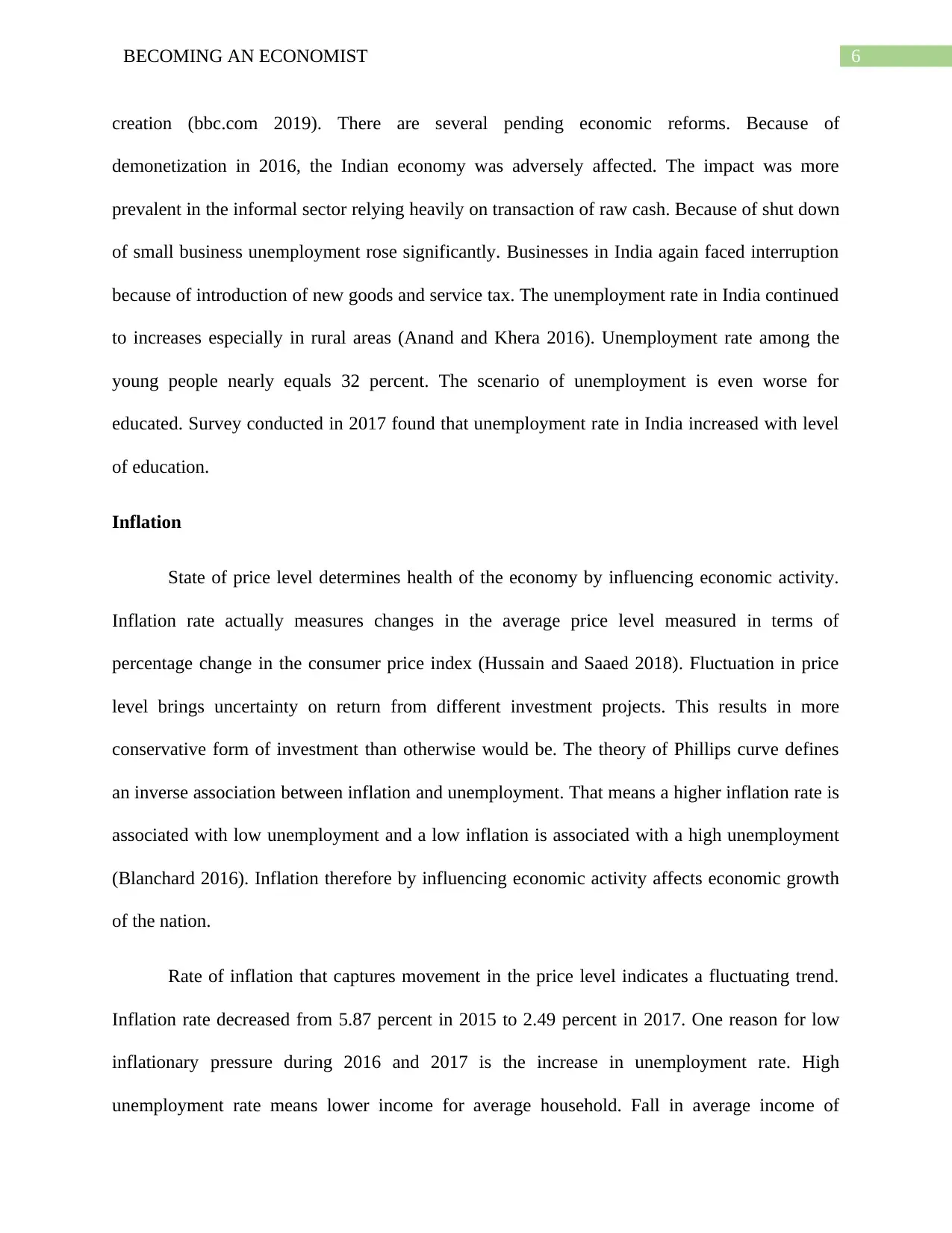
6BECOMING AN ECONOMIST
creation (bbc.com 2019). There are several pending economic reforms. Because of
demonetization in 2016, the Indian economy was adversely affected. The impact was more
prevalent in the informal sector relying heavily on transaction of raw cash. Because of shut down
of small business unemployment rose significantly. Businesses in India again faced interruption
because of introduction of new goods and service tax. The unemployment rate in India continued
to increases especially in rural areas (Anand and Khera 2016). Unemployment rate among the
young people nearly equals 32 percent. The scenario of unemployment is even worse for
educated. Survey conducted in 2017 found that unemployment rate in India increased with level
of education.
Inflation
State of price level determines health of the economy by influencing economic activity.
Inflation rate actually measures changes in the average price level measured in terms of
percentage change in the consumer price index (Hussain and Saaed 2018). Fluctuation in price
level brings uncertainty on return from different investment projects. This results in more
conservative form of investment than otherwise would be. The theory of Phillips curve defines
an inverse association between inflation and unemployment. That means a higher inflation rate is
associated with low unemployment and a low inflation is associated with a high unemployment
(Blanchard 2016). Inflation therefore by influencing economic activity affects economic growth
of the nation.
Rate of inflation that captures movement in the price level indicates a fluctuating trend.
Inflation rate decreased from 5.87 percent in 2015 to 2.49 percent in 2017. One reason for low
inflationary pressure during 2016 and 2017 is the increase in unemployment rate. High
unemployment rate means lower income for average household. Fall in average income of
creation (bbc.com 2019). There are several pending economic reforms. Because of
demonetization in 2016, the Indian economy was adversely affected. The impact was more
prevalent in the informal sector relying heavily on transaction of raw cash. Because of shut down
of small business unemployment rose significantly. Businesses in India again faced interruption
because of introduction of new goods and service tax. The unemployment rate in India continued
to increases especially in rural areas (Anand and Khera 2016). Unemployment rate among the
young people nearly equals 32 percent. The scenario of unemployment is even worse for
educated. Survey conducted in 2017 found that unemployment rate in India increased with level
of education.
Inflation
State of price level determines health of the economy by influencing economic activity.
Inflation rate actually measures changes in the average price level measured in terms of
percentage change in the consumer price index (Hussain and Saaed 2018). Fluctuation in price
level brings uncertainty on return from different investment projects. This results in more
conservative form of investment than otherwise would be. The theory of Phillips curve defines
an inverse association between inflation and unemployment. That means a higher inflation rate is
associated with low unemployment and a low inflation is associated with a high unemployment
(Blanchard 2016). Inflation therefore by influencing economic activity affects economic growth
of the nation.
Rate of inflation that captures movement in the price level indicates a fluctuating trend.
Inflation rate decreased from 5.87 percent in 2015 to 2.49 percent in 2017. One reason for low
inflationary pressure during 2016 and 2017 is the increase in unemployment rate. High
unemployment rate means lower income for average household. Fall in average income of
Paraphrase This Document
Need a fresh take? Get an instant paraphrase of this document with our AI Paraphraser
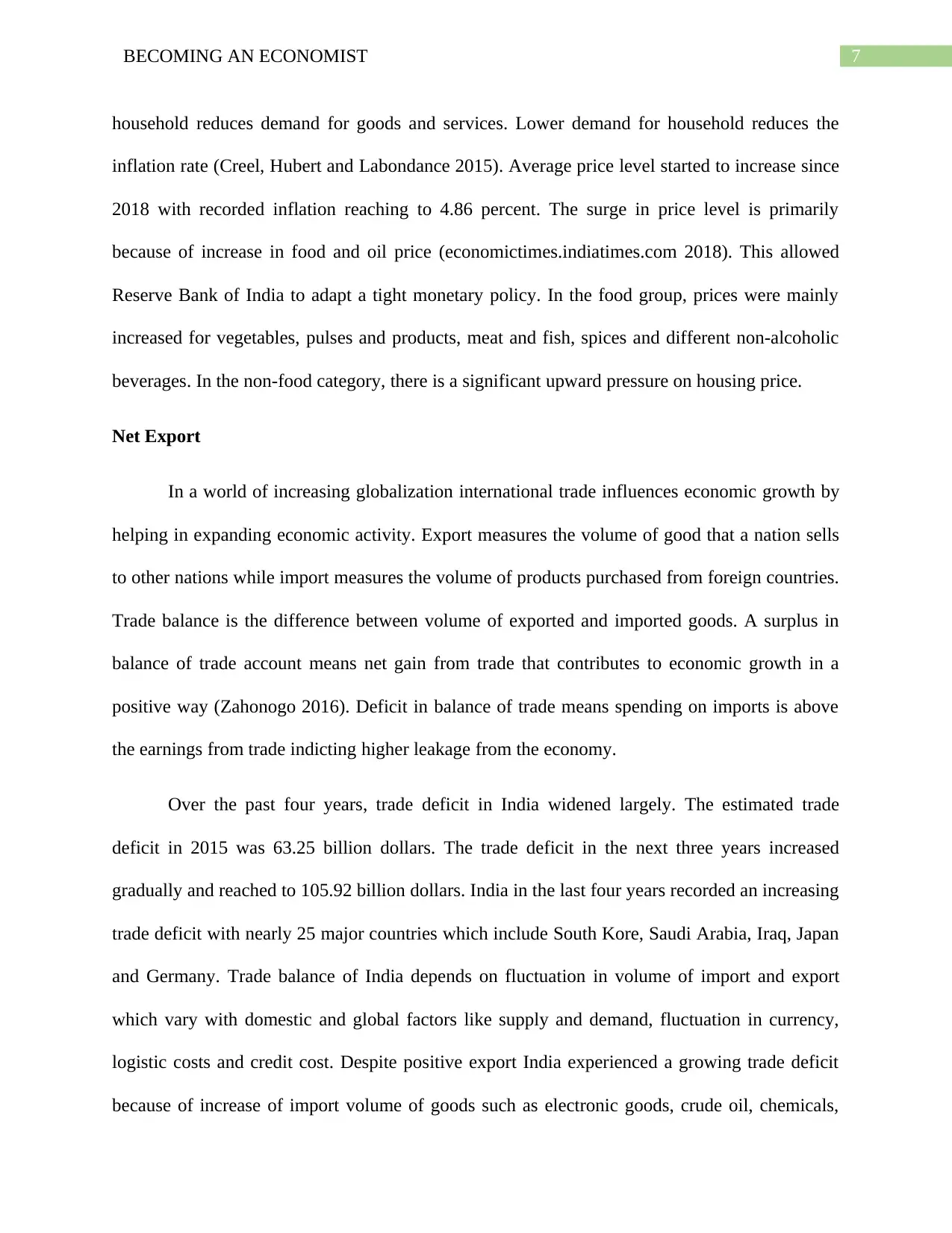
7BECOMING AN ECONOMIST
household reduces demand for goods and services. Lower demand for household reduces the
inflation rate (Creel, Hubert and Labondance 2015). Average price level started to increase since
2018 with recorded inflation reaching to 4.86 percent. The surge in price level is primarily
because of increase in food and oil price (economictimes.indiatimes.com 2018). This allowed
Reserve Bank of India to adapt a tight monetary policy. In the food group, prices were mainly
increased for vegetables, pulses and products, meat and fish, spices and different non-alcoholic
beverages. In the non-food category, there is a significant upward pressure on housing price.
Net Export
In a world of increasing globalization international trade influences economic growth by
helping in expanding economic activity. Export measures the volume of good that a nation sells
to other nations while import measures the volume of products purchased from foreign countries.
Trade balance is the difference between volume of exported and imported goods. A surplus in
balance of trade account means net gain from trade that contributes to economic growth in a
positive way (Zahonogo 2016). Deficit in balance of trade means spending on imports is above
the earnings from trade indicting higher leakage from the economy.
Over the past four years, trade deficit in India widened largely. The estimated trade
deficit in 2015 was 63.25 billion dollars. The trade deficit in the next three years increased
gradually and reached to 105.92 billion dollars. India in the last four years recorded an increasing
trade deficit with nearly 25 major countries which include South Kore, Saudi Arabia, Iraq, Japan
and Germany. Trade balance of India depends on fluctuation in volume of import and export
which vary with domestic and global factors like supply and demand, fluctuation in currency,
logistic costs and credit cost. Despite positive export India experienced a growing trade deficit
because of increase of import volume of goods such as electronic goods, crude oil, chemicals,
household reduces demand for goods and services. Lower demand for household reduces the
inflation rate (Creel, Hubert and Labondance 2015). Average price level started to increase since
2018 with recorded inflation reaching to 4.86 percent. The surge in price level is primarily
because of increase in food and oil price (economictimes.indiatimes.com 2018). This allowed
Reserve Bank of India to adapt a tight monetary policy. In the food group, prices were mainly
increased for vegetables, pulses and products, meat and fish, spices and different non-alcoholic
beverages. In the non-food category, there is a significant upward pressure on housing price.
Net Export
In a world of increasing globalization international trade influences economic growth by
helping in expanding economic activity. Export measures the volume of good that a nation sells
to other nations while import measures the volume of products purchased from foreign countries.
Trade balance is the difference between volume of exported and imported goods. A surplus in
balance of trade account means net gain from trade that contributes to economic growth in a
positive way (Zahonogo 2016). Deficit in balance of trade means spending on imports is above
the earnings from trade indicting higher leakage from the economy.
Over the past four years, trade deficit in India widened largely. The estimated trade
deficit in 2015 was 63.25 billion dollars. The trade deficit in the next three years increased
gradually and reached to 105.92 billion dollars. India in the last four years recorded an increasing
trade deficit with nearly 25 major countries which include South Kore, Saudi Arabia, Iraq, Japan
and Germany. Trade balance of India depends on fluctuation in volume of import and export
which vary with domestic and global factors like supply and demand, fluctuation in currency,
logistic costs and credit cost. Despite positive export India experienced a growing trade deficit
because of increase of import volume of goods such as electronic goods, crude oil, chemicals,
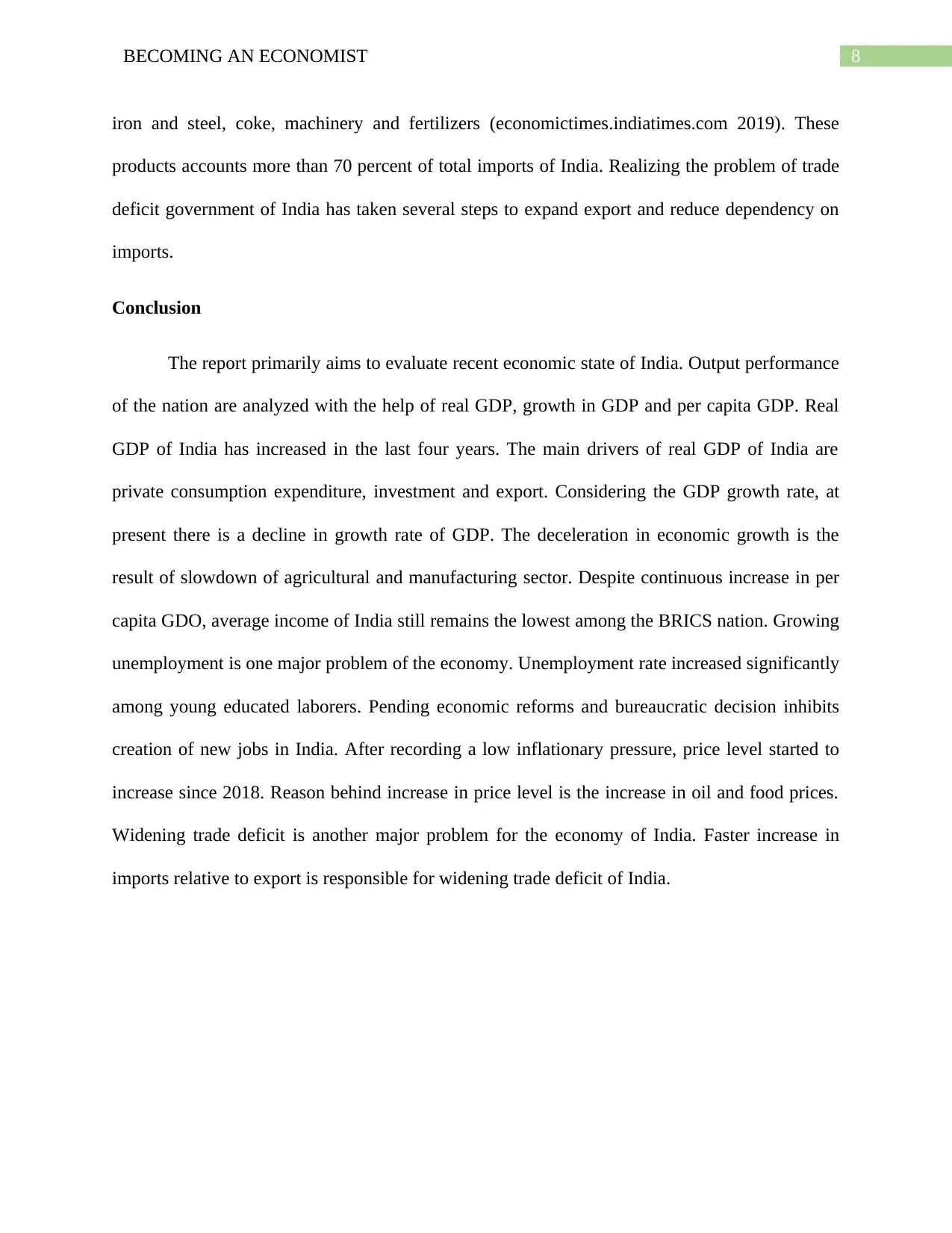
8BECOMING AN ECONOMIST
iron and steel, coke, machinery and fertilizers (economictimes.indiatimes.com 2019). These
products accounts more than 70 percent of total imports of India. Realizing the problem of trade
deficit government of India has taken several steps to expand export and reduce dependency on
imports.
Conclusion
The report primarily aims to evaluate recent economic state of India. Output performance
of the nation are analyzed with the help of real GDP, growth in GDP and per capita GDP. Real
GDP of India has increased in the last four years. The main drivers of real GDP of India are
private consumption expenditure, investment and export. Considering the GDP growth rate, at
present there is a decline in growth rate of GDP. The deceleration in economic growth is the
result of slowdown of agricultural and manufacturing sector. Despite continuous increase in per
capita GDO, average income of India still remains the lowest among the BRICS nation. Growing
unemployment is one major problem of the economy. Unemployment rate increased significantly
among young educated laborers. Pending economic reforms and bureaucratic decision inhibits
creation of new jobs in India. After recording a low inflationary pressure, price level started to
increase since 2018. Reason behind increase in price level is the increase in oil and food prices.
Widening trade deficit is another major problem for the economy of India. Faster increase in
imports relative to export is responsible for widening trade deficit of India.
iron and steel, coke, machinery and fertilizers (economictimes.indiatimes.com 2019). These
products accounts more than 70 percent of total imports of India. Realizing the problem of trade
deficit government of India has taken several steps to expand export and reduce dependency on
imports.
Conclusion
The report primarily aims to evaluate recent economic state of India. Output performance
of the nation are analyzed with the help of real GDP, growth in GDP and per capita GDP. Real
GDP of India has increased in the last four years. The main drivers of real GDP of India are
private consumption expenditure, investment and export. Considering the GDP growth rate, at
present there is a decline in growth rate of GDP. The deceleration in economic growth is the
result of slowdown of agricultural and manufacturing sector. Despite continuous increase in per
capita GDO, average income of India still remains the lowest among the BRICS nation. Growing
unemployment is one major problem of the economy. Unemployment rate increased significantly
among young educated laborers. Pending economic reforms and bureaucratic decision inhibits
creation of new jobs in India. After recording a low inflationary pressure, price level started to
increase since 2018. Reason behind increase in price level is the increase in oil and food prices.
Widening trade deficit is another major problem for the economy of India. Faster increase in
imports relative to export is responsible for widening trade deficit of India.
⊘ This is a preview!⊘
Do you want full access?
Subscribe today to unlock all pages.

Trusted by 1+ million students worldwide
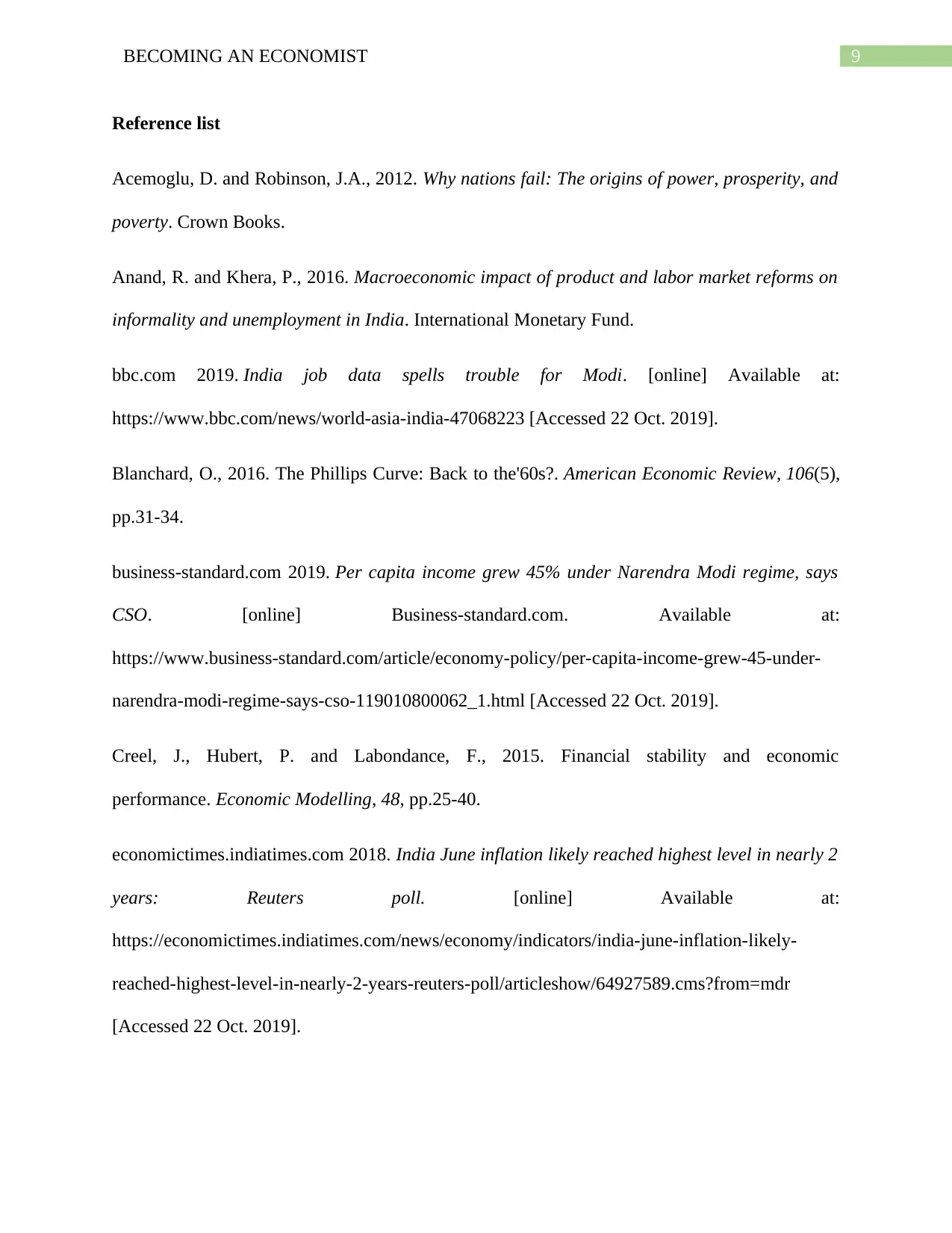
9BECOMING AN ECONOMIST
Reference list
Acemoglu, D. and Robinson, J.A., 2012. Why nations fail: The origins of power, prosperity, and
poverty. Crown Books.
Anand, R. and Khera, P., 2016. Macroeconomic impact of product and labor market reforms on
informality and unemployment in India. International Monetary Fund.
bbc.com 2019. India job data spells trouble for Modi. [online] Available at:
https://www.bbc.com/news/world-asia-india-47068223 [Accessed 22 Oct. 2019].
Blanchard, O., 2016. The Phillips Curve: Back to the'60s?. American Economic Review, 106(5),
pp.31-34.
business-standard.com 2019. Per capita income grew 45% under Narendra Modi regime, says
CSO. [online] Business-standard.com. Available at:
https://www.business-standard.com/article/economy-policy/per-capita-income-grew-45-under-
narendra-modi-regime-says-cso-119010800062_1.html [Accessed 22 Oct. 2019].
Creel, J., Hubert, P. and Labondance, F., 2015. Financial stability and economic
performance. Economic Modelling, 48, pp.25-40.
economictimes.indiatimes.com 2018. India June inflation likely reached highest level in nearly 2
years: Reuters poll. [online] Available at:
https://economictimes.indiatimes.com/news/economy/indicators/india-june-inflation-likely-
reached-highest-level-in-nearly-2-years-reuters-poll/articleshow/64927589.cms?from=mdr
[Accessed 22 Oct. 2019].
Reference list
Acemoglu, D. and Robinson, J.A., 2012. Why nations fail: The origins of power, prosperity, and
poverty. Crown Books.
Anand, R. and Khera, P., 2016. Macroeconomic impact of product and labor market reforms on
informality and unemployment in India. International Monetary Fund.
bbc.com 2019. India job data spells trouble for Modi. [online] Available at:
https://www.bbc.com/news/world-asia-india-47068223 [Accessed 22 Oct. 2019].
Blanchard, O., 2016. The Phillips Curve: Back to the'60s?. American Economic Review, 106(5),
pp.31-34.
business-standard.com 2019. Per capita income grew 45% under Narendra Modi regime, says
CSO. [online] Business-standard.com. Available at:
https://www.business-standard.com/article/economy-policy/per-capita-income-grew-45-under-
narendra-modi-regime-says-cso-119010800062_1.html [Accessed 22 Oct. 2019].
Creel, J., Hubert, P. and Labondance, F., 2015. Financial stability and economic
performance. Economic Modelling, 48, pp.25-40.
economictimes.indiatimes.com 2018. India June inflation likely reached highest level in nearly 2
years: Reuters poll. [online] Available at:
https://economictimes.indiatimes.com/news/economy/indicators/india-june-inflation-likely-
reached-highest-level-in-nearly-2-years-reuters-poll/articleshow/64927589.cms?from=mdr
[Accessed 22 Oct. 2019].
Paraphrase This Document
Need a fresh take? Get an instant paraphrase of this document with our AI Paraphraser
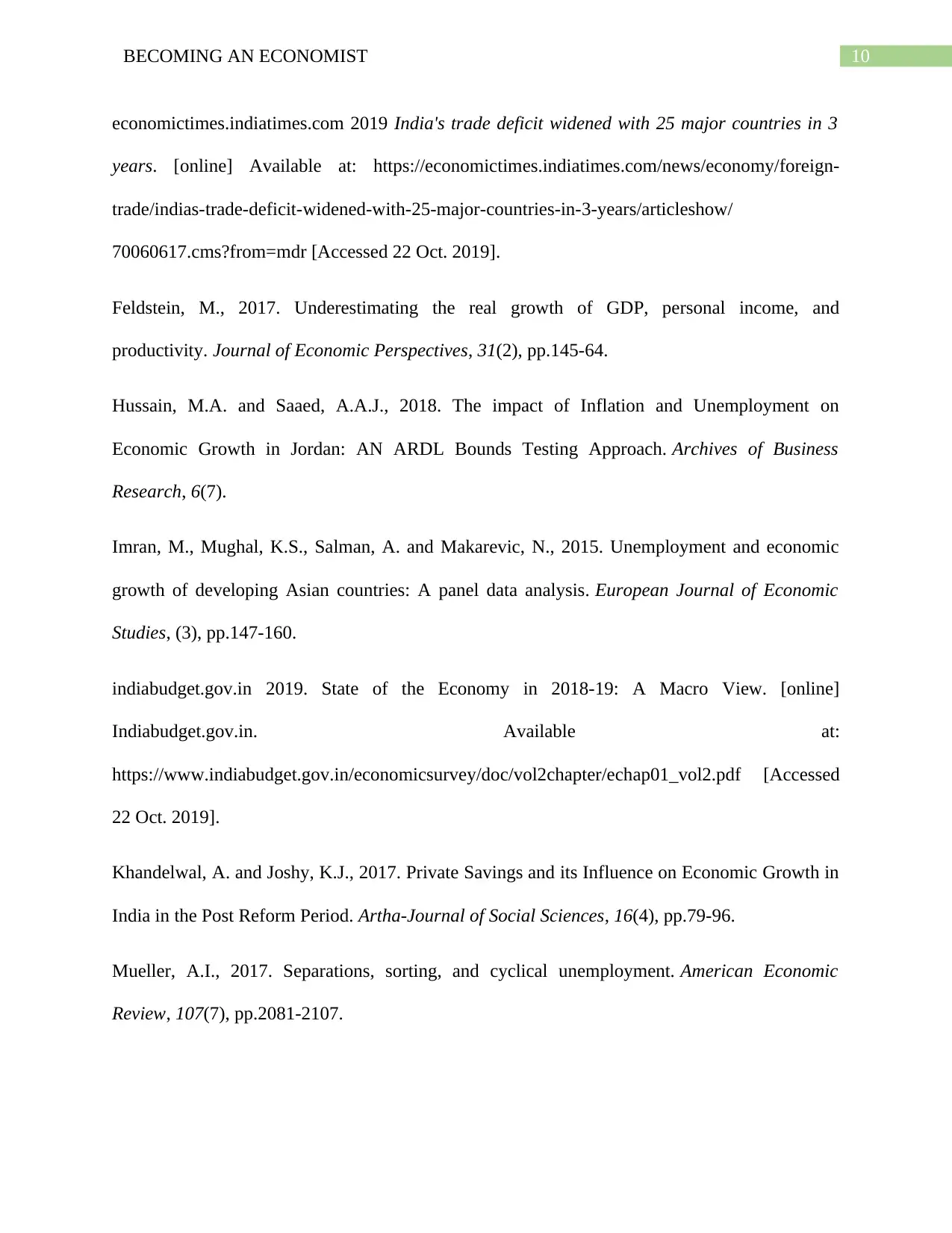
10BECOMING AN ECONOMIST
economictimes.indiatimes.com 2019 India's trade deficit widened with 25 major countries in 3
years. [online] Available at: https://economictimes.indiatimes.com/news/economy/foreign-
trade/indias-trade-deficit-widened-with-25-major-countries-in-3-years/articleshow/
70060617.cms?from=mdr [Accessed 22 Oct. 2019].
Feldstein, M., 2017. Underestimating the real growth of GDP, personal income, and
productivity. Journal of Economic Perspectives, 31(2), pp.145-64.
Hussain, M.A. and Saaed, A.A.J., 2018. The impact of Inflation and Unemployment on
Economic Growth in Jordan: AN ARDL Bounds Testing Approach. Archives of Business
Research, 6(7).
Imran, M., Mughal, K.S., Salman, A. and Makarevic, N., 2015. Unemployment and economic
growth of developing Asian countries: A panel data analysis. European Journal of Economic
Studies, (3), pp.147-160.
indiabudget.gov.in 2019. State of the Economy in 2018-19: A Macro View. [online]
Indiabudget.gov.in. Available at:
https://www.indiabudget.gov.in/economicsurvey/doc/vol2chapter/echap01_vol2.pdf [Accessed
22 Oct. 2019].
Khandelwal, A. and Joshy, K.J., 2017. Private Savings and its Influence on Economic Growth in
India in the Post Reform Period. Artha-Journal of Social Sciences, 16(4), pp.79-96.
Mueller, A.I., 2017. Separations, sorting, and cyclical unemployment. American Economic
Review, 107(7), pp.2081-2107.
economictimes.indiatimes.com 2019 India's trade deficit widened with 25 major countries in 3
years. [online] Available at: https://economictimes.indiatimes.com/news/economy/foreign-
trade/indias-trade-deficit-widened-with-25-major-countries-in-3-years/articleshow/
70060617.cms?from=mdr [Accessed 22 Oct. 2019].
Feldstein, M., 2017. Underestimating the real growth of GDP, personal income, and
productivity. Journal of Economic Perspectives, 31(2), pp.145-64.
Hussain, M.A. and Saaed, A.A.J., 2018. The impact of Inflation and Unemployment on
Economic Growth in Jordan: AN ARDL Bounds Testing Approach. Archives of Business
Research, 6(7).
Imran, M., Mughal, K.S., Salman, A. and Makarevic, N., 2015. Unemployment and economic
growth of developing Asian countries: A panel data analysis. European Journal of Economic
Studies, (3), pp.147-160.
indiabudget.gov.in 2019. State of the Economy in 2018-19: A Macro View. [online]
Indiabudget.gov.in. Available at:
https://www.indiabudget.gov.in/economicsurvey/doc/vol2chapter/echap01_vol2.pdf [Accessed
22 Oct. 2019].
Khandelwal, A. and Joshy, K.J., 2017. Private Savings and its Influence on Economic Growth in
India in the Post Reform Period. Artha-Journal of Social Sciences, 16(4), pp.79-96.
Mueller, A.I., 2017. Separations, sorting, and cyclical unemployment. American Economic
Review, 107(7), pp.2081-2107.
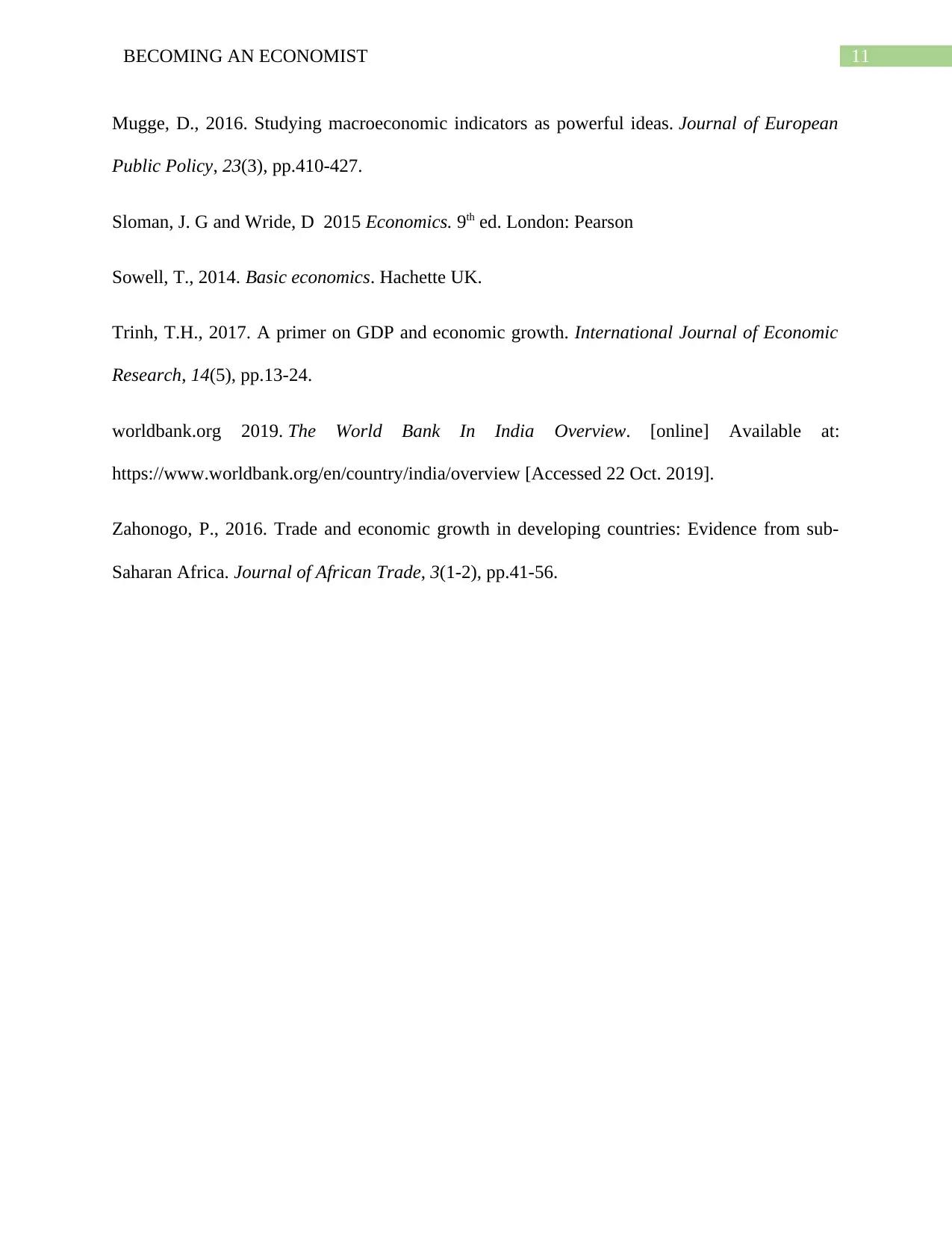
11BECOMING AN ECONOMIST
Mugge, D., 2016. Studying macroeconomic indicators as powerful ideas. Journal of European
Public Policy, 23(3), pp.410-427.
Sloman, J. G and Wride, D 2015 Economics. 9th ed. London: Pearson
Sowell, T., 2014. Basic economics. Hachette UK.
Trinh, T.H., 2017. A primer on GDP and economic growth. International Journal of Economic
Research, 14(5), pp.13-24.
worldbank.org 2019. The World Bank In India Overview. [online] Available at:
https://www.worldbank.org/en/country/india/overview [Accessed 22 Oct. 2019].
Zahonogo, P., 2016. Trade and economic growth in developing countries: Evidence from sub-
Saharan Africa. Journal of African Trade, 3(1-2), pp.41-56.
Mugge, D., 2016. Studying macroeconomic indicators as powerful ideas. Journal of European
Public Policy, 23(3), pp.410-427.
Sloman, J. G and Wride, D 2015 Economics. 9th ed. London: Pearson
Sowell, T., 2014. Basic economics. Hachette UK.
Trinh, T.H., 2017. A primer on GDP and economic growth. International Journal of Economic
Research, 14(5), pp.13-24.
worldbank.org 2019. The World Bank In India Overview. [online] Available at:
https://www.worldbank.org/en/country/india/overview [Accessed 22 Oct. 2019].
Zahonogo, P., 2016. Trade and economic growth in developing countries: Evidence from sub-
Saharan Africa. Journal of African Trade, 3(1-2), pp.41-56.
⊘ This is a preview!⊘
Do you want full access?
Subscribe today to unlock all pages.

Trusted by 1+ million students worldwide
1 out of 13
Related Documents
Your All-in-One AI-Powered Toolkit for Academic Success.
+13062052269
info@desklib.com
Available 24*7 on WhatsApp / Email
![[object Object]](/_next/static/media/star-bottom.7253800d.svg)
Unlock your academic potential
Copyright © 2020–2025 A2Z Services. All Rights Reserved. Developed and managed by ZUCOL.





